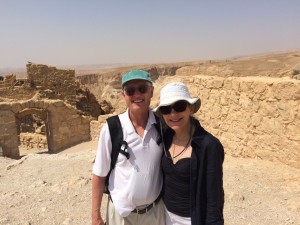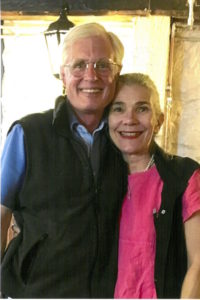 This week, I decided to leave Lent for just a moment and return to a prior blog on the subject of Church and State separation. The origin of the expression “separation of church and state” derives from a letter Thomas Jefferson wrote to the Danbury Baptist Association. In 1802, the Danbury Baptist Association wrote a letter to Jefferson voicing concern that their state constitution lacked specific protections for religious freedom.
This week, I decided to leave Lent for just a moment and return to a prior blog on the subject of Church and State separation. The origin of the expression “separation of church and state” derives from a letter Thomas Jefferson wrote to the Danbury Baptist Association. In 1802, the Danbury Baptist Association wrote a letter to Jefferson voicing concern that their state constitution lacked specific protections for religious freedom.
In the letter, they wrote, “What religious privileges we enjoy (as a minor part of the State) we enjoy as favors granted, and not as inalienable rights. And these favors we receive at the expense of such degrading acknowledgments, as are inconsistent with the rights of freemen.”
Background to the Letter
To fully understand the concern of the Danbury Baptist Association, it’s important to go back into history. The concept of freedom of religion that we Americans take for granted much of the time, did not exist in Europe of their day. Originally, all of Europe was Roman Catholic. The state and the church existed in a symbiotic relationship. Neither was inclined to allow challenges to its authority.
The Protestant Reformation shattered the religious unity of Europe, leading to the emergence of two powerful groups: the Roman Catholic Church and the Protestant churches existing within the boundaries of the various European States. Within the Protestant movement, there were divisions, one of which was the Baptist, a minority in Europe and the United States at the time, and often persecuted. Virginia, originally a crowned colony, had the church of England as the established church.
Religious Freedom. All Protestant groups feared that the United States would emulate Europe and create an established church. The Anglican church, of which leaders like Washington were members and which was powerful in Virginia, was a prime candidate. These Protestant groups were adamant that the United States did not have an established church.
Political Involvement. Of equal importance is the fact that the hegemony of the Roman Catholic Church and the various kingdoms of Europe often resulted in the suppression of opposing opinions, religious and secular. The church in the state often worked in tandem to be certain that opinions of which one of them did not agree, were suppressed. In England, where many of the colonists were from, the Church of England took the place of the Roman Catholic Church during the Reformation. There were strong connections between the church of England and the king. Views that were unacceptable to either were suppressed. The Baptist had been one of those groups. In other European countries, for example, France, protestant groups were also persecuted.
In the colonies, the churches enjoyed a remarkable degree of freedom. Pastors from the pulpit would criticize governments, policies, and other matters. They defended their own theological positions, often using words that were extremely critical of their opponents. In particular, many of the protestant groups, criticize the Roman Catholic Church and any established church. Naturally, they did not want to give up this freedom.
One example is the American Revolution. Pastors played an important role in the lead up to the revolution, and many served in Washington’s army. As an example, in 1774, wto full years before the Declaration of Independence, the Provincial Congress of Massachusetts stated:
“…we cannot but acknowledge the goodness of Heaven in constantly supplying us with preachers of the Gospel whose concern has been the temporal and spiritual happiness of this people…and do therefore recommend…that they assist us in avoiding that dreadful slavery with which we are now threatened…” [1]
Jonas Clark, Pastor of the Church in Lexington, Massachusetts, was a case in point. He actively authored many papers recording the town’s position on liberty. Without him, there may have been no “shot heard round the world!” [2]
The point is not to argue the precise details of the causes of the American Revolution or its support. Economic, political, religious, social, cultural, and other factors at work in the American Revolution. Nevertheless, churches played a role with other institutions in the circumstances surrounding the American Revolution.
Jefferson’s Response
Jefferson, who was by no means the most religious of the Founders, himself a deist, responded to the letter defending religious liberty:
Believing with you that religion is a matter which lies solely between Man & his God, that he owes account to none other for his faith or his worship, that the legitimate powers of government reach actions only, & not opinions, I contemplate with sovereign reverence that act of the whole American people which declared that their legislature should “make no law respecting an establishment of religion, or prohibiting the free exercise thereof,” thus building a wall of separation between Church & State. Adhering to this expression of the supreme will of the nation in behalf of the rights of conscience, I shall see with sincere satisfaction the progress of those sentiments which tend to restore to man all his natural rights, convinced he has no natural right in opposition to his social duties. [3]
Several things about this response are immediately evident. First, Jefferson speaks of “natural rights.” He believed that freedom of speech was an inherent natural right of people that should not be interfered with by the government. Second, as a result, the government should not suppress matters of faith and worship or the public expression of views. Third, the government retains the right to enact laws and compel compliance for the benefit of society.
The Purpose of the Phrase “Wall of Separation”
Contrary to much current opinion, the phrase “a wall of separation” was not intended to indicate that religion should not influence opinion on issues. Instead, it was used to affirm free religious practice for citizens. In our society, the phrase is too often used to deny religious people the right to speak about their views in public life. It’s a mistake. One good example has to do with the run-up to the American Civil War in the North; pastors were among those most urgent about ending slavery. Another good example is the Civil Rights Movement in the South during the 1960s. Many Civil Rights Movement leaders were pastors who voiced their religious convictions about segregation.
This week, I wrote an old friend about a personal story related to these events. Not many years ago, one of those pastors, who was quite elderly, broke down in tears during a Presbyterian meeting. He had lost his job during the 1960s supporting segregation and couldn’t understand why people would not allow him to express his views on other public matters in our day and age. It was pretty touching. This pastor was accused of being a racist on the floor of the Presbytery over a matter unrelated to race. I was present that day and saw that pastor and others of his generation bow their heads in anguish.
The Practical Purpose of the Blog
We live in times of social unrest about many issues. There are divisions between secular people and among Christians concerning many matters of public importance. Abortion, sexuality, war, capital punishment, and many other issues divide us. I’ve argued in different places that the solution to this problem does not lie within our current method of handling conflict. Currently, we fight battles in government and media, elect the majority, and they oppose their views upon society. This is only the end of a wise process of public decision-making.
Over the last four years, I have been trying to promote what I call a sophio-agapic, or “love and wisdom,” pragmaticist approach that uses dialogue as a foundation for decision-making. In an unpublished book I am writing, I make the following point:
Many commentators have written on the lack of effective dialogue in Western Society today. In Congress and State Legislatures the degree of open hostility and unwillingness to compromise and dialogue about serious problems are endemic. More concerning is the fact that dialogue has become increasingly impossible in families, neighborhood associations, churches, and other mediating institutions and organizations. Even debate is ineffective if either no one is listening or, as is increasingly the case, everyone has made up their mind before the debate begins. A lack of authentic community dialogue results in poor decision-making and gridlock. It is also responsible for the increasing alienation of many people from the values of a democratic society. [4]
I might easily be wrong, but I believe that our democracy’s health requires that we return to the process of building community, discussing issues with respect for the opinions of others, allowing minorities to express their views freely, and seeking compromise. Public debate seeks a vote to finally determine an issue. Dialogue involves a conversation to bring clarity and a complete understanding of the options to the parties to a dispute. This consists of the potential for compromise among alternatives.
I had lunch this week with a friend who has different political and religious beliefs from my own. We were able to discuss some pretty significant issues. Neither of us was convinced of the position of the others. We did, however, come to some understanding and even drew closer in our evaluation of a political situation. This is the benefit of dialogue. Dialogue cannot wholly replace the give-and-take, the push-and-shove, the policy decisions, and the reversal of policy decisions that characterize politics. It’s not even a guarantee of decision-making. It’s simply a guarantee of a better decision-making mode and a better chance of avoiding policy errors.
In our nation, such dialogue will be between secular people and religious people and among various religions and sects within religious groups. Both secular and religious people will be convinced of the truth of their ultimate opinions about reality. They will also be confident of the truth about many views on social issues. As the philosopher Michael Polanyi reminds us, the search for truth always involves a public declaration of what one believes and the willingness to defend one’s intuition. It also comes with the desire to examine one’s position and its factual and theoretical support and be willing to modify one position based upon new information. The purpose of dialogue is to facilitate that process.
Copyright 2024, G. Christopher Scruggs, All Rights Reserved
[1] Verna M. Hall, Christian History of the American Revolution, (Chesapeake VA: Foundation for American Christian Education, 1976), 402 found at https://heritageministriesky.com/2019/01/17/pastors-inspired-the-american-revolution-3/ (downloaded March 7, 2024).
[2] Id.
[3] Thomas Jefferson, “Jefferson’s Letter to the Danbury Baptists The Final Letter as Sent” (January 1, 1802), downloeaded from the Library of Congress, https://www.loc.gov/loc/lcib/9806/danpre.html (March 7, 2024).
[4] G. Christopher Scruggs., A “Sophia-Agapic” Approach to Political Philosophy: Essays on a Constructive Post-Ideological Politics (Unpublished Manuscript, 2024).














